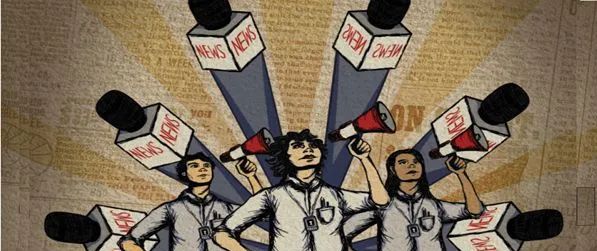As Kashmir’s media environment transforms in the age of social media, the fine line between grassroots reporting and sensationalism is becoming increasingly blurred.
By: Javid Amin | Srinagar | 07 July 2025
A Changing Media Valley
In the heart of the Himalayas, Kashmir has always been a region marked by beauty, conflict, resilience—and journalism. For decades, local journalists have risked their lives to report stories from one of the most politically sensitive zones in the world. But over the past few years, the region’s media landscape has undergone a profound transformation. With the rise of smartphones and internet penetration, especially after the restoration of 4G services, a new wave of content creators has emerged. Many call themselves journalists—but without any formal training or media ethics background.
What was once a profession defined by courageous field reporting, editorial scrutiny, and factual accountability is now seeing increasing interference from what many call “self-styled journalists”—individuals who prioritize speed and virality over accuracy and context.
This shift is not unique to Kashmir, but here, where the stakes are already high due to the region’s complex socio-political fabric, it carries profound implications. What happens when news is replaced by noise? When likes outweigh facts? And when journalism becomes performance rather than profession?
From Gatekeepers to Grassroots: Journalism in the Digital Age
Historically, Kashmir’s journalistic narrative has been shaped by dedicated professionals working under immense constraints. From the 1990s insurgency to 2019’s Article 370 abrogation, Kashmir’s press has navigated censorship, intimidation, and logistical blackouts.
However, the past five years have marked a fundamental shift. Thanks to social media platforms like Facebook, X (formerly Twitter), Instagram, and YouTube, anyone with a smartphone can now broadcast live, publish news, and build a following.
This has democratized access to news creation. Local stories—like water shortages in Handwara or school closures in Anantnag—are now covered in real time by residents, sometimes before legacy media catches up.
But this digital empowerment also brings risks. Without editorial oversight, misinformation can spread rapidly. The pressure to go viral has led to oversimplification or outright exaggeration of events. Newsroom training is often replaced with influencer-style tactics.
The Rise of the Self-Styled Journalist
In Kashmir, a new breed of media actors has emerged: self-styled journalists. They command thousands, even millions, of views by covering hyperlocal, emotional, or dramatic content. Videos about school results, crescent moon sightings for Eid, weather updates, and religious gatherings now garner more attention than investigative exposés on corruption or conflict.
While these topics aren’t inherently trivial, the concern lies in their disproportionate coverage and the motivations behind it. Many content creators admit that they choose viral topics simply to grow their following or attract monetization deals.
Aijaz Ahmad, a veteran journalist based in Srinagar, observes:
“The biggest challenge we face is the lack of professional standards. Many self-styled journalists do not adhere to basic journalism principles, which can lead to inaccurate or biased reporting.”
The consequences can be severe. False rumors about communal tensions, weather-related warnings, or health scares can spread panic. In a region where misinformation has life-and-death consequences, accuracy isn’t optional—it’s essential.
Impact on Credibility: Blurring the Lines
As self-styled journalists multiply, the credibility of Kashmir’s overall media ecosystem is under threat. Residents, already wary due to historical censorship and propaganda, now struggle to differentiate between legitimate news and attention-seeking content.
Ghulam Nabi, a senior media analyst, explains:
“This trend is eroding the credibility of journalism in Kashmir. We need to promote professional journalism standards and support quality journalism initiatives to maintain the integrity of our industry.”
Public trust in media has dropped. A 2024 informal survey conducted by Kashmir Media Watch found that over 62% of respondents said they “don’t trust most news unless it’s from a known media house.” Yet, ironically, over 74% consumed news primarily through social media.
This paradox—high consumption, low trust—is dangerous. It creates fertile ground for disinformation campaigns, communal divisions, and political manipulation.
The Ethics Gap: When Influence Beats Integrity
One of the core pillars of journalism is ethics—fairness, verification, accountability, and independence. But many self-styled journalists operate without these guardrails.
Some common ethical issues include:
- Lack of source verification: Many reports rely on hearsay or unverified claims.
- Sensational headlines: Designed to attract clicks, not inform.
- Biased reporting: Amplifying one side of a story without offering context or counterpoints.
- Privacy violations: Publishing names or photos of minors, victims, or sensitive subjects without consent.
These practices dilute the journalistic profession, making it harder for trained reporters to be taken seriously.
Voices from the Ground: What Citizens Think
To understand public sentiment, we spoke with several Kashmiris across age groups and occupations:
Rukhsana Jan, a schoolteacher from Pulwama:
“Sometimes the videos shared on social media are informative. But often, they just create fear. Like during last year’s floods—so much fake news was circulating.”
Zahid Lone, a journalism student at Kashmir University:
“I follow both old newspapers and YouTubers. But I notice that the older ones give more background, while the new ones just jump to conclusions.”
Bilal Ahmed, a farmer from Shopian:
“We don’t have time to read big articles. We watch quick videos. But we don’t know who to trust.”
These comments reflect a mix of appreciation and apprehension. The speed and accessibility of citizen reporting are welcome—but so is the demand for quality and integrity.
Training & Support: Bridging the Knowledge Gap
To address these concerns, media professionals and civil society groups have begun offering workshops and trainings on media literacy, ethical reporting, and fact-checking. Some notable initiatives:
- Kashmir Press Club (before suspension) had initiated a rural journalism program to train local storytellers.
- Kashmir Observer partnered with fact-checkers to run awareness campaigns.
- International Center for Journalists (ICFJ) has supported digital storytelling workshops in the region.
But these efforts are often underfunded, irregular, and inaccessible to remote areas. Scaling them up is crucial.
The Way Forward: A Hybrid Future?
Is there a middle path between traditional and citizen journalism? Many experts believe so.
Combining the reach of digital media with the discipline of legacy journalism can create a hybrid model. This might include:
- Mentorship networks: Experienced journalists guiding newcomers.
- Certification programs: Basic journalism ethics training for content creators.
- Verification tools: Promoting use of fact-check apps among citizen journalists.
- Platform accountability: Encouraging Facebook, YouTube, and others to promote accurate sources in Kashmir-based content.
Crucially, audiences must be educated to question, verify, and reflect—not just consume.
Bottom-Line: Journalism with Integrity
Kashmir stands at a crossroads. Its journalism ecosystem—once a symbol of fearless reporting under fire—is now battling an identity crisis. While the digital era offers immense potential for inclusivity and real-time reporting, it also demands greater responsibility.
We need a collective commitment: from journalists, content creators, platforms, and the public. By promoting truth, accuracy, and ethics, Kashmir can reclaim the dignity and power of its press.
In a region as sensitive and vibrant as Kashmir, journalism must be more than content—it must be conscience.


